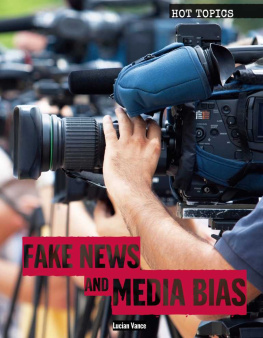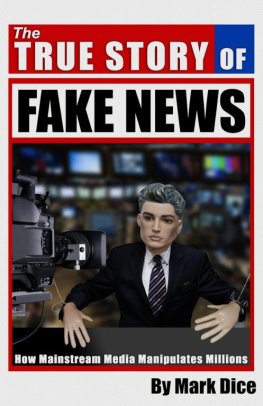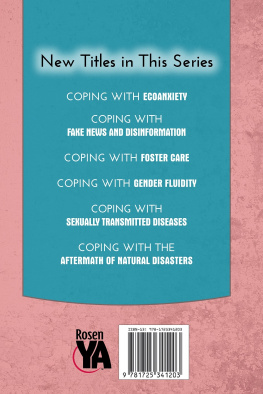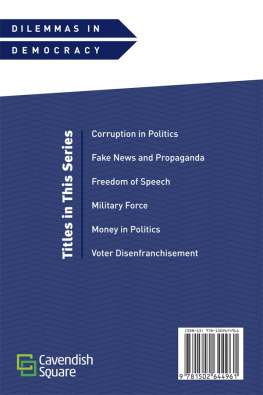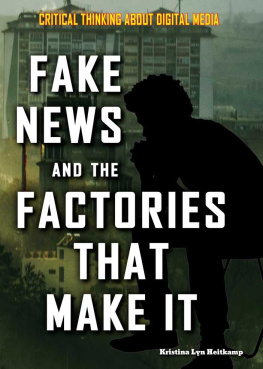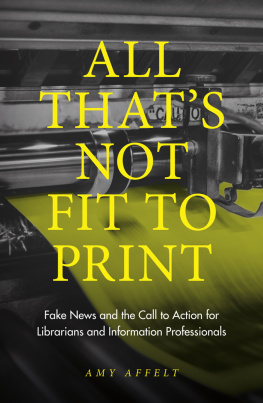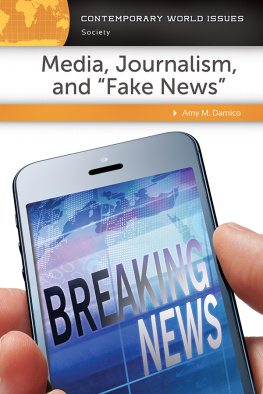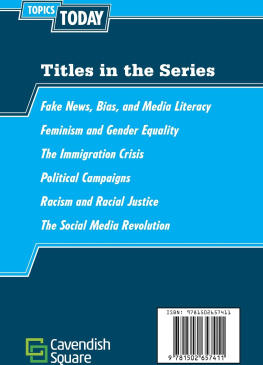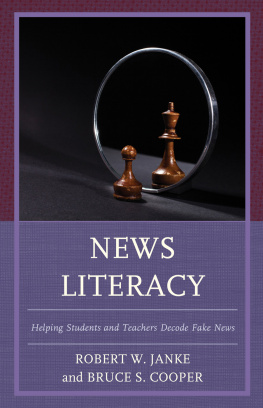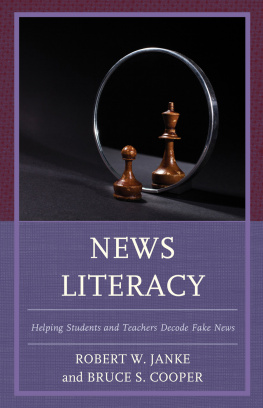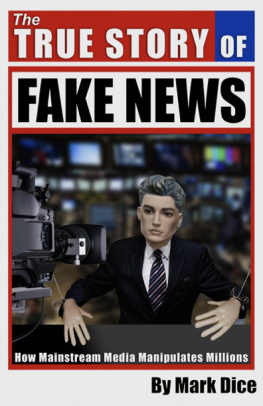Published in 2018 by
Lucent Press, an Imprint of Greenhaven Publishing, LLC
353 3rd Avenue Suite 255
New York, NY 10010
Copyright 2018 Greenhaven Press, a part of Gale, Cengage Learning
Gale and Greenhaven Press are registered trademarks used herein under license.
All new materials copyright 2018 Lucent Press, an Imprint of Greenhaven Publishing, LLC.
All rights reserved. No part of this book may be reproduced in any form without permission in writing from the publisher, except by a reviewer.
Designer: Seth Hughes
Editor: Jennifer Lombardo
Library of Congress Cataloging-in-Publication Data
Names: Vance, Lucian.
Title: Fake news and media bias / Lucian Vance.
Description: New York : Lucent Press, 2018. | Series: Hot topics | Includes bibliographical references and index.
Identifiers: LCCN 2017046663| ISBN 9781534561991 (library bound book) | ISBN 9781534562912 (pbk. book) | ISBN 9781534562004 (ebook)
Subjects: LCSH: Journalism-Objectivity-United States. | Mass media-Objectivity-United States. | Fake news-United States.
Classification: LCC PN4888.O25 V36 2018 | DDC 302.230973-dc23 LC record available at https://lccn.loc.gov/2017046663
Printed in the United States of America
CPSIA compliance information: Batch #CW18KL: For further information contact Greenhaven Publishing LLC, New York, New York at 1-844-317-7404.
Please visit our website, www.greenhavenpublishing.com . For a free color catalog of all our high-quality books, call toll free 1-844-317-7404 or fax 1-844-317-7405.
INTRODUCTION |
CHAPTER 1 |
CHAPTER 2 |
CHAPTER 3 |
CHAPTER 4 |
CHAPTER 5 |
foreword
A dolescence is a time when many people begin to take notice of the world around them. News channels, blogs, and talk radio shows are constantly promoting one view or another; very few are unbiased. Young people also hear conflicting information from parents, friends, teachers, and acquaintances. Often, they will hear only one side of an issue or be given flawed information. People who are trying to support a particular viewpoint may cite inaccurate facts and statistics on their blogs, and news programs present many conflicting views of important issues in our society. In a world where it seems everyone has a platform to share their thoughts, it can be difficult to find unbiased, accurate information about important issues.
It is not only facts that are important. In blog posts, in comments on online videos, and on talk shows, people will share opinions that are not necessarily true or false, but can still have a strong impact. For example, many young people struggle with their body image. Seeing or hearing negative comments about particular body types online can have a huge effect on the way someone views himself or herself and may lead to depression and anxiety. Although it is important not to keep information hidden from young people under the guise of protecting them, it is equally important to offer encouragement on issues that affect their mental health.
The titles in the Hot Topics series provide readers with different viewpoints on important issues in todays society. Many of these issues, such as teen pregnancy and Internet safety, are of immediate concern to young people. This series aims to give readers factual context on these crucial topics in a way that lets them form their own opinions. The facts presented throughout also serve to empower readers to help themselves or support people they know who are struggling with many of the challenges adolescents face today. Although negative viewpoints are not ignored or downplayed, this series allows young people to see that the challenges they face are not insurmountable. Eating disorders can be overcome, the Internet can be navigated safely, and pregnant teens do not have to feel hopeless.
Quotes encompassing all viewpoints are presented and cited so readers can trace them back to their original source, verifying for themselves whether the information comes from a reputable place. Additional books and websites are listed, giving readers a starting point from which to continue their own research. Chapter questions encourage discussion, allowing young people to hear and understand their classmates points of view as they further solidify their own. Full-color photographs and enlightening charts provide a deeper understanding of the topics at hand. All of these features augment the informative text, helping young people understand the world they live in and formulate their own opinions concerning the best way they can improve it.
introduction
History of Media Bias
T he news media is one of the most important parts of a free society. Their duty is to tell the truth to help people understand what is happening in the world around them and make informed decisions. When journalists allow their own personal biases to affect the way they report the news, they hurt their viewers by spreading misinformation that is incorrect at best and dangerous at worst.
Adding to the media bias problem is the issue of fake news, which has been gaining more attention since the 2016 presidential election. As the Internet has become an ever-present part of 21st-century life, it has become more difficult to take things online at face value. One popular meme pokes fun at this phenomenon by attributing a quote, The problem with quotes on the Internet is that it is hard to verify their authenticity, to Abraham Lincoln. Sometimes the meme is accompanied by a picture of Benjamin Franklin, implying that he is Lincoln. This meme points out that just because something can be found online does not make it true.
People often use incorrect facts and misleading photos to influence the opinions of others, and if they do their job well enough, they can sometimes even affect things such as the way people cast their votes for certain candidates or policies. Thinking critically about information is more important than ever in an age where anyone with an Internet connection can present their opinions as fact without providing any kind of proof.
The Spread of Bias
Hundreds of American newspapers, magazines, and other publications, as well as numerous television and radio shows, are devoted to news and commentary. The growth of the Internet has provided opportunities for almost anyone in the world to reach audiences that have often totaled in the millions. Tens of thousands of blogs report news and commentary, and these are available to anyone with Internet access. There is no dedicated person or group watching what news outlets print; the U.S. government has no role in ensuring that stories appearing in the press are unbiased. Therefore, it is up to the media themselves to decide whether their presentations of the news are biased. In some cases, when readers or critics point out cases of bias, news organizations are quick to respond and correct the record.
Bias can emerge in several ways. One reason for biased reporting is to attract viewers who hold a certain viewpoint. For instance, Fox News tends to attract conservative viewers, while CNN tends to attract liberal viewers. Other news outlets and blogs are generally also slanted in one direction or another some much more than others. Another reason for bias is that journalists and media owners use their power over the press to promote political leaders and the policies they favor. Sometimes bias can be very subtle. A journalist may develop a preconceived notion of how a story should be told before they conduct the first interviews. When this happens, the reporter will generally seek out interviewees who can be counted on to provide comments that will be in agreement with the way the journalist sees the story. Sometimes bias even happens unintentionally. Many people, even reporters, believe the news should be unbiased. However, as reporter Timothy Stanley wrote in an article for CNN, The press is staffed by human beings, and those human beings have prejudices conditioned by race, class, gender and religion.

